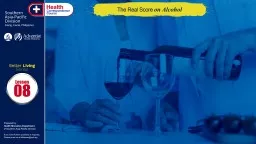

Epidemiological data One out of every ten American adults who drink has a drinking problem yet only 15 of them seek formal help For every alcoholic there are four people who are directly affected by his or her problem Drunk driving accounts for the largest number of deaths in the 1524 year ID: 908468
Download Presentation The PPT/PDF document "Although it is true that an occasional d..." is the property of its rightful owner. Permission is granted to download and print the materials on this web site for personal, non-commercial use only, and to display it on your personal computer provided you do not modify the materials and that you retain all copyright notices contained in the materials. By downloading content from our website, you accept the terms of this agreement.
Slide1
Slide2Although it is true that an occasional drink is not normally harmful, any form of regular drinking is a potential health hazard. The liver is the organ most susceptible to the noxious effects of alcohol, and the end result of 20 years of alcoholism could be cirrhosis. Even from the time you take your first drink, however, alcohol impairs liver function and puts you in a high- risk group for high blood pressure, heart disease, cancer, gastric irritation, pancreatitis, malnutrition, fatty liver, mineral deficiencies, and even an impairment of sexual performance in men.
Slide3Epidemiological data: One out of every ten American adults who drink has a drinking problem, yet only 15% of them seek formal help. For every alcoholic, there are four people who are directly affected by his or her problem. Drunk driving accounts for the largest number of deaths in the 15-24 year age group, and alcohol is involved in half of all traffic fatalities. Alcohol abuse is one of the leading causes of nutritional deficiencies among American adults.
Fetal
alcohol syndrome is one of the three major causes of infant mental retardation.
Slide4Alcoholics are more likely to suffer from depression, suicide attempts, death in fires and are more likely to be perpetrators or victims of violent crimes. It is also a factor in 45-68% of spouse-abuse cases and up to 38% of child-abuse cases.
Slide5SIDE EFFECTS OF ALCOHOL USE
Alcohol impairs mental and physical functions. It also contributes to obesity; lead to poor nutrition; raises susceptibility to infectious diseases; causes cirrhosis of the liver; increases cancer risk and heart attack; it robs a person’s self control; encourages violent and criminal
behavior
; it can lead to suicide and family abuse; in pregnant women it can damage the unborn child or might produce mentally retarded child; high blood pressure; impaired sexual function;
Slide6DISTINCT FACTS YOU SHOULD KNOW
Alcohol is a drug. It changes how you feel and act. When people are drunk, they often have trouble walking and doing other simple tasks. Drinking coffee or taking a cold shower won’t lower the amount of alcohol in your bloodstream. A can of beer, a glass of wine and a mixed drink all have about the same amount of alcohol. Heavy drinking can cause memory problems. It can damage the liver and heart. Signs of alcoholism include drinking alone and hiding bottles. Alcoholism is a disease. Needing alcohol to have fun may be a sign of a drinking problem. With support and treatment, many alcoholics are able to stop drinking and rebuild their lives.
Slide7PREVENTION
Limit your drinking as much as possible. Do not drink alcohol during pregnancy or prior to breast feeding. Do not drink and drive. Do not mix alcohol and drugs. If your father or mother is an alcoholic, be wary of abusing alcohol. If you are suffering from alcohol withdrawal, eat a high carbohydrate diet.
You don’t have to drink just because other people are drinking. Saying no to alcohol helps you stay in control of your actions. No drinking. No hangover. No regrets.
Slide8GOD’S WAY TO ULTIMATE HEALTH
Encircle the word or that make the paragraph wrong
and put a check if it is right.
Alcohol is a drug.
When people are drunk, they had no trouble walking and doing other simple tasks.
A can of beer, a glass of milk and a mixed drink all have about the same amount of alcohol.
Heavy drinking can cause memory problems.
Alcoholism is a psychiatric disease.
. . .
Slide9GOD’S WAY TO ULTIMATE HEALTH
Encircle the word or that make the paragraph wrong
and put a check if it is right.
For every alcoholic, there are ten people who are directly affected by his or her problem.
Drunk driving accounts for the largest number of deaths in the elderly.
Fetal
alcohol syndrome is one of the three major causes of infant mental retardation.
Drink alcohol when pregnant.
Do not mix alcohol and drugs.
Slide10NAME: ______________________________________
ADDRESS: ______________________________________
AGE: ______________________________________